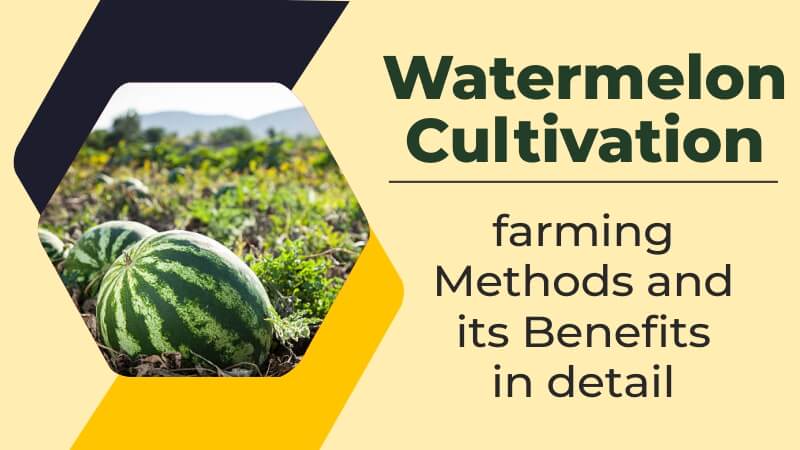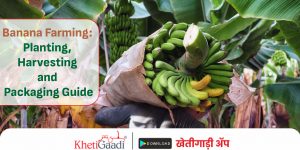Watermelons were initially cultivated for their high water content and stored to be consumed during dry seasons since they contain a lot of water. The unique aspect of watermelon production is that it can be grown with less water and fertilizer at a minimal cost, so farmers do not need to wait for the monsoon to cultivate it. Do you know the native countries of watermelons? They are indigenous to Africa and have been raised since the dawn of civilization. Amazingly, watermelon is the main component of summer fruit because it has few calories and is 93% water by weight. Because of this, it is frequently drunk during the summer. We’ll discuss how the watermelon growing industry is profitable in this blow. Because it can be easily grown on irrigated soil, watermelon is a zaid crop.
Benefits of Watermelon:
- Watermelon has a 90% water content as well as numerous essential electrolytes. As a result, it is an excellent moisturizing agent. The fruit also has a lot of fiber, which can help with digestion.
- Lycopene is one of many carotenoids found in abundance in the fruit. It is anti-inflammatory to consume this carotenoid. Watermelons can therefore be used to alleviate inflammation.
- These fruits, which are high in vitamin C, can help strengthen immunity. Vitamin B6, which helps the immune system produce antibodies and RBCs, is also included in it. Vitamin A can also aid in the prevention of infections.
- Vitamins C and A are abundant in watermelons. These two vitamins support the growth and healing of new skin cells. As a result, it can also aid in the renewal and health of the skin.
- Additionally, this fruit can aid with weight loss. Due to its high water content, it can aid in boosting metabolism, eliminating toxins from the body, and making you feel full on fewer calories.
- We can finish by saying that the fruits make for some incredible energy-boosting beverages. The cool, refreshing flavor rapidly hydrates your body and helps you beat the heat. In general, watermelons are comforting during India’s sweltering summers.
Agricultural practices:
In India, watermelon is a significant cucurbitaceous vegetable or fruit. It is a wonderful fruit for deserts, and its juice has proteins, minerals, and carbohydrates in addition to 92% water. Maharashtra, Karnataka, Tamil Nadu, Punjab, Rajasthan, Madhya Pradesh, and Uttar Pradesh are the primary states where watermelons are grown.
Climate and Soil:
For watermelon, loamy soil with good drainage is ideal. In the heat, the earth shouldn’t crack, and during the rainy season, it shouldn’t be soggy. It’s crucial that soil be productive and abundant in organic materials. The pH range that works best is between 6.0 and 7.0.
Because it is a warm-season crop, watermelon cannot endure even a slight frost or powerful winds. Below 11°C, seeds do not germinate; above 18°C, germination is optimal; and as the temperature rises, germination increases to 30°C. A temperature range of 18 to 24 C is ideal for watermelon growth. Melons prefer a tropical climate with high temperatures, with daytime highs of 35 to 40 °C. Melons produce fruits of higher quality when the nights and days are cool.
The different varieties of watermelon are:
Arun Watermelon, Apoorva Watermelon, Anmol Yellow Watermelon, Dragon King Water Melon, Jaguar Watermelon F1, and others
Sowing Period:
- Melons can be planned throughout the year with the aforementioned growth parameters, but only when the weather is warm and dry throughout fruit development.
- Only watermelons that can withstand rain should be grown during the wet season.
- can be farmed all year in southern and central India.
Techniques for planting
in situ method: In-situ method of sowing is primarily used in watermelon.
Furrow method: 1 to 1.5 m-long furrows are dug, with seeding typically taking place on top of the sides. During the summer, vines are permitted to trail along the ground.
Bed system: In some areas, a bed system is popular, where seeds are distributed around the edges of the beds. The width of the bed is almost twice as wide as the distance between rows.
Hill method: The hills are spaced at a distance of 0.5 to 0.75 meters apart, and 2-3 seeds are seeded on each hill. After germination, only one or two plants per hill are kept.
Treatment of seeds, control of nurseries, and transplanting:
Although seeds for watermelon are typically large, nursery growing may not be necessary because of this. Better germination, improved survivorship, and higher yields may still be achieved by treating seeds with various protective chemicals. Before planting, seeds can be soaked in a mixture of Ridomet (0.5 gm/L), Plantomycin (0.5 gm/L), and Humic Acid (V-Hume) (5 mL/L) to treat them chemically.
Irrigation:
In spring and summer crops, irrigation frequency is crucial, however in crops grown during the rainy season, evenly spaced rainfall from July to September minimizes irrigation frequency. A day or two before seeds are sown, ridges, hills, or beds should be watered. Four to five days later, mild irrigation should be applied. It is important to minimize crust formation on the topsoil and avoid flooding of slopes. Depending on the soil, location, temperature, etc., irrigation should be done once every 5 or 6 days. If flowering, fruit set, or fruit development are taking place, irrigation water shouldn’t get on the vines or vegetative components. In order to prevent damage to developing fruits, it is crucial to maintain beds or the intervals between rows as dry as possible. Wetting will encourage illnesses and the rotting of fruits.
To Know more about pineapple farming and other crops, install the KhetiGuru application that provides you with all agricultural information and also gives you expert advice for farming-related problems. To get the tractor, tractor price related information visit the KhetiGaadi website.




